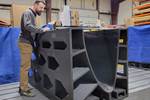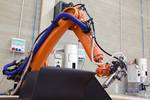CEAD, AES kick off U.S. symposium highlighting LFAM ecosystem
CEAD Flexbot print cell demonstrations and industry presentations showcased the emerging options in 3D printing for polymers, composites and more at AES’ Akron facility.
CEAD Group Inc. (Detroit, Mich., U.S.), and Additive Engineering Solutions, (AES) recently hosted a symposium on large-format additive manufacturing (LFAM) featuring a demonstration with the CEAD Flexbot multi-axis robotic print cell at AES’ Akron, Ohio facility. Serving as a master class for LFAM technologies, the event was attended by 30 visitors representing 17 companies in various market segments — aerospace, defense, architecture, toolmaking and construction — as well as individuals from universities.
In 2023, AES and CEAD established a North America partnership which included installation of the Flexbot print cell to support customer development projects. “We were impressed with the global leadership position of CEAD Flexbot systems,” notes Austin Schmidt, CEO of AES. “With over 150 systems printing worldwide and an extensive research division for emerging Flexbot options, we decided that CEAD was the partner of choice for our investment.”
Notable presentations were featured by Airtech Advanced Materials Group (Huntington Beach, Calif., U.S.) and Adaxis USA Inc. (Chattanooga, Tenn., U.S.). Airtech’s Gregory Haye, additive manufacturing director, provided a technical overview of available polymers, supported by extensive end-use applications and processing data printed on the company’s Flexbot cell in Tennessee. California-based Justin Ferguson, application engineer, representing the new Adaxis U.S. branch, showcased programming features, such as automated secure part fixation on the print bed. The system’s “raft generator” feature automatically creates rafts to mechanically secure parts to CEAD’s print bed, minimizing material use. The Flexbot was 3D printing live to demonstrate the molds and tooling workflow with Adaxis’ “AdaOne for Flexbot” slicing.
CEAD notes that parties that joined the event were interested about the ability to customize the Flexbot system by adding linear rails, rotary tables, datalogging monitoring and CEAD broad portfolio of extruders. Due to the flexibility of the system and its scalability over time, CEAD says it facilitates the future growth of a company.
Notably, CEAD has also been working on a Scan2Mill feature, together with datalogging options, to collect print processing variables, all of which are features for its turnkey Flexbot solution and “AdaOne for Flexbot” software in collaboration with Adaxis. “With (local) support readily available, a plethora of material options, and improved user experiences due to innovations such as ‘AdaOne for Flexbot,’ the LFAM ecosystem has reached a level of maturity that excites people to integrate LFAM into their production processes” says Schmidt.
Technical support during the event was provided by AES and CEAD team members from North America and Europe. CEAD Group’s North American technical sales engineer, Hugo Poisson Guibert, answered detailed questions about multi-planar printing, advanced polymers and layer times with the Flexbot.
Based on the market response, CEAD and its U.S. partners expect to hold additional open house symposiums in the future.
Related Content
-
Plant tour: Spirit AeroSystems, Belfast, Northern Ireland, U.K.
Purpose-built facility employs resin transfer infusion (RTI) and assembly technology to manufacture today’s composite A220 wings, and prepares for future new programs and production ramp-ups.
-
Carbon fiber, bionic design achieve peak performance in race-ready production vehicle
Porsche worked with Action Composites to design and manufacture an innovative carbon fiber safety cage option to lightweight one of its series race vehicles, built in a one-shot compression molding process.
-
A new era for ceramic matrix composites
CMC is expanding, with new fiber production in Europe, faster processes and higher temperature materials enabling applications for industry, hypersonics and New Space.

















